Compound ions Study guides, Revision notes & Summaries
Looking for the best study guides, study notes and summaries about Compound ions? On this page you'll find 3789 study documents about Compound ions.
Page 2 out of 3.789 results
Sort by
![AQA GCSE CHEMISTRY 8462/1F Paper 1 Foundation Tier Version: 1.0 Final *JUN2384621F01* IB/M/Jun23/E11 8462/1F QUESTION PAPER & MARKING SCHEME/ [MERGED]](/docpics/4384869/65ba8505db490_4384869_121_171.jpeg)
-
AQA GCSE CHEMISTRY 8462/1F Paper 1 Foundation Tier Version: 1.0 Final *JUN2384621F01* IB/M/Jun23/E11 8462/1F QUESTION PAPER & MARKING SCHEME/ [MERGED]
- Exam (elaborations) • 71 pages • 2024
- Available in package deal
-
- £6.47
- 1x sold
- + learn more
AQA GCSE CHEMISTRY 8462/1F Paper 1 Foundation Tier Version: 1.0 Final *JUN2384621F01* IB/M/Jun23/E11 8462/1F For Examiner’s Use Question Mark 1 2 3 4 5 6 7 8 9 10 11 TOTAL Monday 22 May 2023 Morning Time allowed: 1 hour 45 minutes Materials For this paper you must have: • a ruler • a scientific calculator • the periodic table (enclosed). Instructions • Use black ink or black ball-point pen. • Pencil should only be used for drawing. • Fill in the box...
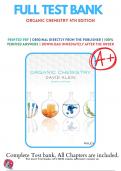
-
Test Bank for Organic Chemistry, 4th Edition by David R. Klein | 9781119659594|Chapter 1-27 | All Chapters with Answers and Rationals
- Exam (elaborations) • 2151 pages • 2023
- Available in package deal
-
- £19.54
- 17x sold
- + learn more
Test Bank for Organic Chemistry 4e 4th Edition by David R. Klein. ISBN-13: 9594 Full chapters test bank PDF TABLE OF CONTENTS 1 A Review of General Chemistry: Electrons, Bonds, and Molecular Properties 1 1.1 Introduction to Organic Chemistry 2 1.2 The Structural Theory of Matter 3 1.3 Electrons, Bonds, and Lewis Structures 4 1.4 Identifying Formal Charges 7 1.5 Induction and Polar Covalent Bonds 8 1.6 Reading Bond-Line Structures 11 1.7 Atomic Orbitals 14 1.8 Valence Bond Theory 17 1.9 Molecular...
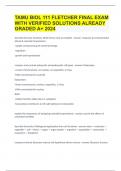
-
TAMU BIOL 111 FLETCHER FINAL EXAM WITH VERIFIED SOLUTIONS ALREADY GRADED A+
- Exam (elaborations) • 36 pages • 2023
- Available in package deal
-
- £12.13
- 1x sold
- + learn more
describe the basic functions all life forms must accomplish -response to environmental stimuli & maintain homeostasis -uptake and processing of nutrients/energy -regulation -growth and reproduction compare and contrast eukaryotic and prokaryotic cell types Prokaryotes: -circular chromosomes, no nucleus, no organelles, 3.5 bya -DNA concentrated in nucleoid Eukaryotes: -linear chromosomes, nucleus, organelles, 1.5 bya -DNA concentrated in nucleus Both: -cellular function takes p...
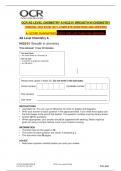
-
OCR AS LEVEL CHEMISTRY A H032/01 BREADTH IN CHEMISTRY ORIGINAL 2024 EXAM 100 % COMPLETE QUESTIONS AND ANSWERS A+ SCORE GUARANTEED.CHECK THE LAST PAGE FOR ANSWERS.
- Exam (elaborations) • 34 pages • 2023
- Available in package deal
-
- £10.51
- 1x sold
- + learn more
OCR AS LEVEL CHEMISTRY A H032/01 BREADTH IN CHEMISTRY ORIGINAL 2024 EXAM 100 % COMPLETE QUESTIONS AND ANSWERS A+ SCORE GUARANTEED.CHECK THE LAST PAGE FOR ANSWERS. 1 Which substance contains polar molecules? A C2H4 B CO2 C NCl 3 D SF6 Your answer [1] 2 What is the formula of silver carbonate? A AgCO3 B Ag(CO3)2 C Ag2CO3 D Ag3CO3 Your answer [1] 3 Which statement explains why ice is less dense than water? A Hydrogen bonds are stronger in ice than in water. B H...
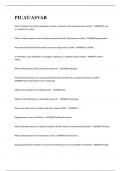
-
PICAT/ASVAB
- Exam (elaborations) • 16 pages • 2023
-
- £12.54
- 1x sold
- + learn more
PICAT/ASVAB Which of these is the best explanation of how a smooth round stone became smooth? - ANSWER-It was in a stream for a long When a lobster grows a claw to replace one that was lost, the process is called - ANSWER-regeneration. Any astronomical body that revolves around a larger body is called - ANSWER-a satellite. In chemistry, to be classified as an organic substance, a substance must contain - ANSWER-Carbon atoms. Which element does NOT contain any neutrons? - ANSWER-hy...
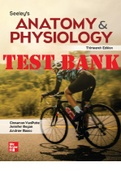
-
TEST BANK for Seeley's Anatomy & Physiology 13th Edition by Cinnamon VanPutte, Jennifer Regan, Andrew Russo. All Chapters 1-29. (Complete Download) 1751 Pages
- Exam (elaborations) • 1751 pages • 2023
- Available in package deal
-
- £14.57
- 7x sold
- + learn more
Version 1 1 CHAPTER 1 1) Which technique creates a three-dimensional dynamic image of blood vessels? A) Digital subtraction angiography B) Magnetic resonance imaging C) Dynamic spatial reconstruction D) Positron emission tomography 2) Magnetic resonance imaging is based on the movement of A) electrons in a magnetic field. B) carbons in a magnetic field. C) protons in a magnetic field. D) cells in a magnetic field. 3) The delivery of a radioactive compound to the body to study the met...
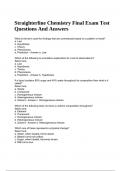
-
Straighterline Chemistry Final Exam Test Questions And Answers.
- Exam (elaborations) • 43 pages • 2023
-
- £9.30
- 1x sold
- + learn more
Straighterline Chemistry Final Exam Test Questions And Answers. What is the term used for findings that are summarized based on a pattern or trend? a. Law b. Hypothesis c. Theory d. Phenomena e. Prediction - Answer a. Law Which of the following is a tentative explanation for a set of observations? Select one: a. Law b. Hypothesis c. Theory d. Phenomena e. Prediction - Answer b. Hypothesis If a liquid contains 60% sugar and 40% water throughout its composition then what is it calle...
![AQA AQA GCSE CHEMISTRY 8462/1F Paper 1 Foundation Tier Version: 1.0 Final *JUN2384621F01* IB/M/Jun23/E11 8462/1FQUESTION PAPER & MARKING SCHEME/ [MERGED] Marl( scheme June 2023](/docpics/4428432/65c11b201bcd6_4428432_121_171.jpeg)
-
AQA AQA GCSE CHEMISTRY 8462/1F Paper 1 Foundation Tier Version: 1.0 Final *JUN2384621F01* IB/M/Jun23/E11 8462/1FQUESTION PAPER & MARKING SCHEME/ [MERGED] Marl( scheme June 2023
- Exam (elaborations) • 63 pages • 2024
- Available in package deal
-
- £8.08
- 1x sold
- + learn more
AQA GCSE CHEMISTRY 8462/1F Paper 1 Foundation Tier Version: 1.0 Final *JUN2384621F01* IB/M/Jun23/E11 8462/1F For Examiner’s Use Question Mark 1 2 3 4 5 6 7 8 9 10 11 TOTAL Monday 22 May 2023 Morning Time allowed: 1 hour 45 minutes Materials For this paper you must have: • a ruler • a scientific calculator • the periodic table (enclosed). Instructions • Use black ink or black ball-point pen. • Pencil should only be used for drawing. • Fill in the box...

-
Test Bank For Foundations of College Chemistry 14th Edition Hein
- Exam (elaborations) • 660 pages • 2023
-
- £22.99
- 1x sold
- + learn more
Package Title: Hein Test Bank Course Title: Hein 14e Chapter Number: 3 Question type: Multiple Choice 1) All matter is composed of elements. Approximately how many elements are there? a) 4 b) 10 c) 68 d) 100 Answer: D Difficulty: easy Learning Objective 1: Define an element and write the chemical symbol for an element when given its name. Section Reference 1: Section 3.1 2) The smallest particle of an element that can exist is called a(n) ___. a) atom b) ferrul...
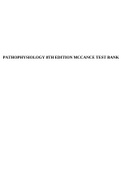
-
PATHOPHYSIOLOGY 8TH EDITION MCCANCE TEST BANK.
- Exam (elaborations) • 493 pages • 2022
- Available in package deal
-
- £20.63
- 4x sold
- + learn more
PATHOPHYSIOLOGY 8TH EDITION MCCANCE TEST BANK. Chapter 1: Cellular Biology MULTIPLE CHOICE 1. Which statement best describes the cellular function of metabolic absorption? a. Cells can produce proteins. c. Cells can take in and use nutrients. b. Cells can secrete digestive enzymes. d. Cells can synthesize fats. ANS: C In metabolic absorption, all cells take in and use nutrients and other substances from their surroundings. The remaining options are not inclusive in their descriptions of c...

Study stress? For sellers on Stuvia, these are actually golden times. KA-CHING! Earn from your revision notes too and start uploading now. Discover all about earning on Stuvia


